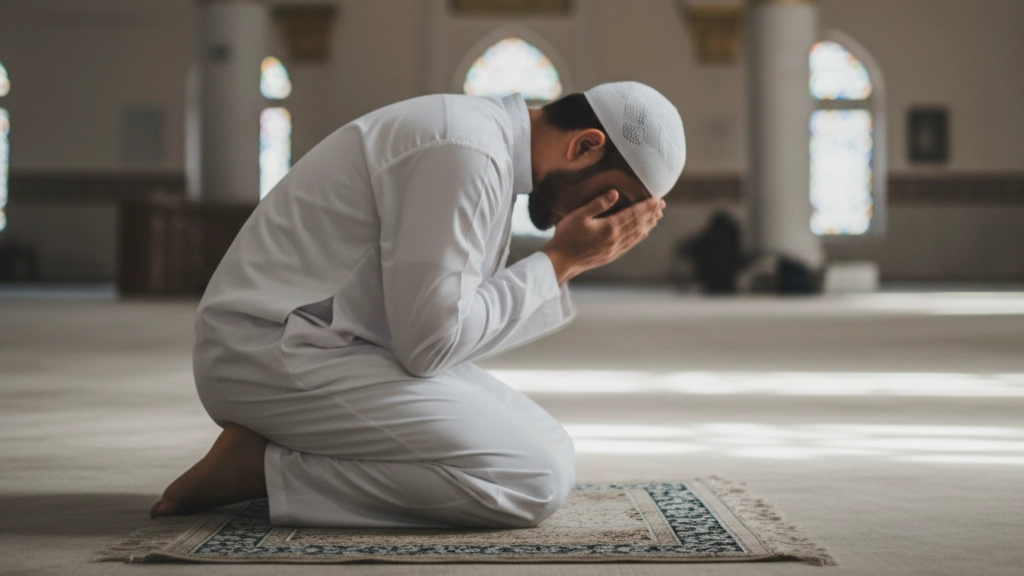Salah (also known as Namaz in many regions) is the second pillar of Islam and the most important act of worship. It is the direct connection between a servant and their Creator. The significance of this act is so profound that the Prophet Muhammad (ﷺ) (peace and blessings be upon him) said:
“The first thing a person will be questioned about on the Day of Judgment is Salah.”
(Tirmidhi)
Given its immense importance, performing Salah correctly is absolutely essential. The Prophet (ﷺ) explicitly instructed his followers,
“Pray as you have seen me praying.”
(Sahih al-Bukhari)
The purpose of this article is to help you identify common mistakes—both major and subtle—that often compromise the completeness and reward of our prayer, and to provide actionable steps to correct them, allowing you to build a stronger, more rewarding spiritual foundation.
See Also: Adhan in Arabic, English Translation
Mistakes Before Starting Salah
The preparation before Salah is as crucial as the prayer itself. Neglecting these steps can invalidate the prayer entirely.
1. Not Performing Wudu Properly

Wudu (ablution) is the ritual purification required for Salah.
- Missing parts of wudu: Forgetting to wash a required limb completely, such as the back of the heel or a small patch on the forearm.
- Rushing through: Performing wudu so quickly that water doesn’t reach all necessary areas.
- Using too little water or wasting water: While one should not waste water, ensuring that the water actually flows over and cleanses the required parts is mandatory.
2. Incorrect Clothing or Exposure of ‘Awrah
The ‘Awrah (parts of the body that must be covered) must be completely covered.
- For Men: The ‘Awrah is from the navel to the knee. Mistakes include wearing shorts that expose the knee or a thin shirt that exposes the back during Ruku and Sujood.
- For Women: The entire body must be covered except for the face and hands. Mistakes include wearing tight, transparent, or short clothes that reveal the body’s shape or skin, or not ensuring the headscarf/veil stays properly covered during prostration.
3. Not Facing the Qibla Properly
Salah must be performed facing the Qibla (the direction of the Kaaba in Makkah).
- Slight direction mistakes: While a slight deviation in a remote location is excusable, in a mosque or known location, facing the correct direction is mandatory.
- Not checking Qibla in new places: Assuming the direction without proper verification when traveling or in a new building.
4. Not Having Proper Intention (Niyyah)
The Niyyah (intention) is the spiritual prerequisite that defines the purpose of the prayer (e.g., “I intend to pray four units of Dhuhr Salah for the sake of Allah“).
- Saying niyyah out loud (not from Sunnah): The Niyyah is a matter of the heart, not the tongue. Verbally declaring it is a common innovation and not from the authentic Sunnah.
- Confusion between verbal and heart intention: Simply feeling the purpose in your heart is sufficient and is the true Niyyah.
Mistakes During Salah

These errors directly affect the quality and validity of the prayer itself.
1. Lack of Khushu (Concentration and Humility)
Khushu is the soul of Salah. It is the state of total submission, humility, and focus on Allah.
- Rushing through prayer: Moving too quickly, which prevents the mind from focusing and the body from settling in each position.
- Thinking about worldly matters: Allowing the mind to wander. While difficult to control, constantly trying to bring the focus back to the words and actions of the prayer is a must.
- Looking around or fidgeting: Direct movement, adjusting clothing unnecessarily, or gazing around the room breaks the focus and is discouraged.
2. Incorrect Postures and Movements
Physical postures in Salah must be performed according to the Sunnah. Every movement reflects respect and submission to Allah ﷻ. Many common mistakes happen when people don’t follow the correct positions carefully.
a) Not Standing Straight in Qiyam
- In the standing position (Qiyam), the body should be upright, balanced, and firm.
- Slouching or leaning reduces the dignity of Salah.
Tip: Keep your back straight, shoulders relaxed but upright, and gaze downward toward the place of prostration.
b) Incomplete Ruku (Bowing)
- During Ruku, the back should be straight and parallel to the ground, with hands resting firmly on the knees.
- Many people bend insufficiently or keep the back loose.
Tip: Bend properly, ensure your back is straight, and pause briefly to observe Tuma’ninah (stillness).
c) Incomplete Sujood (Prostration)
In Sujood, seven body parts must touch the ground according to Sunnah:
- Forehead and nose
- Both palms
- Both knees (joints only, not entire knees)
- Toes of both feet
Important:
- Toes must be bent and pointing toward the Qibla.
- The feet should be upright, with the toes pressing the ground.
- Palms should be flat and firmly placed, elbows off the ground, and the body weight on knees and palms.
❌ Common mistakes: lifting palms, toes not touching, or not bending toes properly.
Tip: Place all required parts firmly, bend your toes toward Qibla, and maintain complete stillness during Sujood.
See Also: The 6 Farz in Namaz (Salah)
d) Not Being Still Between Movements (Tuma’ninah)
Tuma’ninah means pausing and being completely still in each stage of Salah:
- After Ruku
- After rising from Ruku
- In Sujood
- Between the two prostrations
The Prophet (ﷺ) warned against rushing:
“There is no prayer for the one who does not perform it properly, and he steals from his prayer.”
(Sahih Muslim)
❌ Skipping Tuma’ninah is one of the most common mistakes, as it diminishes the quality and acceptance of the prayer.
Tip: Move deliberately, pause briefly at every stage, and ensure your body is still before continuing.
3. Reciting Quran Incorrectly
The words of Allah must be recited with care.
- Mispronouncing Surah Al-Fatihah: This is the most critical mistake, as Fatiha is mandatory in every unit (rak’ah). Serious mispronunciations can change the meaning and invalidate the prayer.
- Skipping verses or reciting too fast: Reciting at a speed that makes the pronunciation unclear or leads to missing words.
- Not pausing at proper places: Ignoring the rules of Tajweed (proper recitation), which affects the beauty and meaning of the recitation.
4. Wrong Placement of Hands
- After Takbir, placing hands too high or low: Hands should be placed on the chest/abdomen area, as specified by the school of thought one follows, and not near the neck or too low near the waist.
- Moving hands unnecessarily: Constant movement of the hands or fingers during the standing posture.
5. Not Following the Imam (for Jama’ah) Properly
In congregational prayer (Jama’ah), following the Imam is mandatory.
- Going before or after Imam: Initiating a movement (like bowing or prostrating) before the Imam is forbidden. One must wait for the Imam to complete the movement before starting. Likewise, intentionally delaying significantly after the Imam is also discouraged.
- Not correcting if mistake happens: If the Imam makes a mistake and you know the correct action, men should say “SubhanAllah” and women should clap their hands to alert the Imam.
See Also: Tahajjud Prayer: Best Time, Dua & Guide
Mistakes After Salah
The time immediately following Salah is one of the most blessed times for supplication and remembrance.

1. Rushing Away Without Dhikr or Dua
- Ignoring tasbeeh and supplications: Skipping the recommended remembrance and supplications, such as reciting Astaghfirullah three times, followed by the specific recitations of Tasbeeh (Subhan’Allah 33 times, Alhamdulillah 33 times, Allahu Akbar 33 times) and then making personal Dua (supplication).
- Missing the opportunity for forgiveness: These post-Salah remembrances are a source of great reward and forgiveness.
2. Lack of Consistency
- Praying irregularly or missing Salah intentionally: While the mistakes during Salah are serious, willfully neglecting or missing a prayer is a major sin. Consistency in all five prayers is the hallmark of a believer.
3. Not Making Up Missed Salah (Qadha)
If a prayer is missed due to a valid, unintentional reason (e.g., sleeping through the time, forgetting), one must make it up (Qadha) as soon as they remember or wake up. Neglecting Qadha is a mistake.
Common Mistakes by Gender

While most rules are universal, some specific practices are worth noting:
- For men: Exposing the shoulders in an undershirt while the rest of the body is covered, or errors in standing in the mosque rows (gaps between feet, not straightening the row).
- For women: Praying without proper hijab (covering the hair and all necessary parts), or excessive movement to readjust clothing during the prayer.
How to Correct These Mistakes

Improving Salah is a journey, not a destination.
- Learn Salah from Authentic Sunnah: Get a reliable book or attend a class that teaches the exact method of the Prophet (ﷺ), focusing on the concept of Tuma’ninah (stillness).
- Practice Slowly with Focus: Consciously slow down every single movement. Say the words of the Dhikr (remembrance) in Ruku and Sujud slowly and with understanding.
- Attend Mosque or Learn from Reliable Scholars: Praying in congregation allows you to observe others and learn the correct postures. Seek guidance from a respected Imam or Islamic teacher.
- Self-Check with a Salah Checklist: Occasionally record or have a trusted person observe your prayer to identify unconscious mistakes, especially the lack of still pauses.
- Understand the Arabic: Learn the meaning of Surah Al-Fatiha and the Dhikr said in Ruku, Sujud, and the final sitting. Understanding what you are saying dramatically improves Khushu.
See Also: Sajda-e-Sahw – Perform the Prostration of Forgetfulness
Conclusion
Salah is not a mere ritual; it is a gift and a direct, private connection with Allah. Every effort you make to perfect your prayer is an investment in your eternal life.
Remember the gravity of the matter, as mentioned in the Hadith:
“The first thing a person will be questioned about on the Day of Judgment is Salah. If it is sound, the rest of his deeds will be sound. And if it is unsound, the rest of his deeds will be unsound.”
(Tabarani)
Start small, focus on Tuma’ninah and Khushu, and take a step-by-step approach to make every prayer your best one yet.



